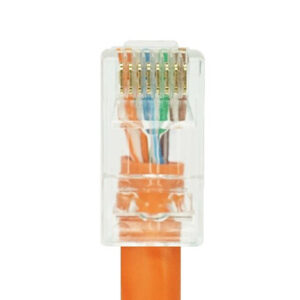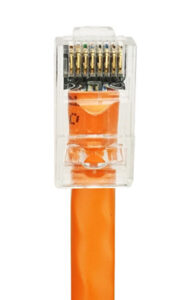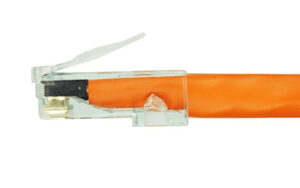You may be familiar with the Meghan Trainor hit song “All About that Bass”. The lyrics go “I’m all ‘bout that bass, ‘bout that bass, no treble”. Kinda sticks in our head when we hear that song, don’t you think; whether we are fans or not. Meghan’s song got into the heads of our engineers here at Simply45 as well. However, we sing this song using slightly different lyrics that go like this …
“I’m all ‘bout those twists, ‘bout those twists, no NEXT”
“I’m all ‘bout those twists, ‘bout those twists, no noise”
When it comes to 10G LAN cable development and manufacturing; when it comes to RJ45 design for supporting Cat6 and 10G LAN cable performance, it is all about limiting crosstalk (NEXT and FEXT) and noise as much as possible to meet the higher performance standards required for these cables and systems.
With RJ45 modular plugs the challenge is how can we substantially reduce the introduction of NEXT and noise into the cable during the termination process?
Differential Signaling
Differential Signaling is a method for electrically transmitting information using two complementary signals (kudos to Wikipedia). With differential signaling over twisted pair cabling, each wire pair carries a signal that is the same voltage but opposite polarity. This improves noise canceling in the native signal.
However, EMI and Crosstalk are two types of interference that can wreck signal performance. EMI or electromagnetic interference from outside sources such as power wires and Crosstalk which is interference from other pairs in the same cable. Both introduce noise into the signal.
Each wire pair uses a different twist rate to improve signal integrity. This negates/reduces crosstalk interference.
[Please pay attention here] The less untwisting of the wire pairs in the RJ45 modular plug improves signal performance by reducing crosstalk interference. This is especially important when using Cat6 and 10G LAN cables such as Cat7a/7/6a. The specifications for the cable performance are very stringent for crosstalk and system noise. This is especially important over longer distance runs.
Best Practices for terminating Cat6 and 10G LAN cables requires you to minimize the lengths of any untwisted wires during the RJ45 termination process. This is “easier said than done”.
Please refer to the two images below. Figure 1 represents a typical Cat6 RJ45 modular plug termination. Figure 2 represents a “Best Practices” Simply45® Cat6 RJ45 termination


Notice how far the Cat6 cable was able to be inserted into the Simply45® RJ45. This significantly minimizes the introduction of crosstalk by substantially reducing the length of untwisted wires inside of the RJ45 modular plug.
Cat6 cables are much more difficult to terminate correctly than Cat5e cables. Cat6 cables have a thicker diameter 23 AWG wire size and there is a center spline or pair separator typically included in most Cat6 UTP cables. The pair separator is required to move the wire pairs further apart, minimizing crosstalk interference.
This all becomes a challenge to correctly terminate Cat6 with most pass-through or standard WE/SS RJ45 modular plugs. It becomes even more challenging when you are trying to terminate 10G LAN cables. So how do you minimize the untwisting of the wire pairs during termination without adding additional crosstalk interference into the signal?
With the typical pass-through or standard RJ45 modular plug design you run into two main issues:
First, Cat6 UTP cables have a larger overall diameter than Cat5e UTP cable. This makes it very difficult for the cable to be correctly inserted into the RJ45. (This is even more pronounced with 10G cables) Too often the installer will have to radically deform the cable by excessively squeezing or pinching to get it partially inserted into the RJ45 modular plug so that it can be crimped/attached to the cable. This excessive squeezing or pinching adversely affects the cable performance in a similar manner as pinching or squeezing the LAN cable during installation behind the walls. You really don’t want to do this. Best cable installation practices preach avoiding over bending or pinching the cable during installation, so why will you do this during RJ45 termination?
Second, because the Cat6 (and 10G) cable cannot fit into the plug the same way as the smaller sized Cat5e UTP cable, more of the wire pairs must be untwisted and left untwisted inside of the RJ45 modular plug. Usually over a 1/4inch (6.4mm) or more of untwisted wire pairs are exposed inside the RJ45 modular plug. [With 10G LAN cables the length of untwisted wires inside the plug is usually much more] This type of termination introduces noise and crosstalk interference right into the signal.
This may not have been a big problem when these cables were being used for just basic LAN applications or very short cable run lengths, but with today’s higher frequency and higher bandwidth signals over Category LAN cables, maximizing cable performance has become more critical. The best LAN cable manufacturers go to great lengths to maximize the performance capabilities of their cables, especially for long-distance installations. However, if you attach a poorly designed RJ45 modular plug or some cheap China made RJ45 onto the cable, the cable performance is going to be negatively affected.
Simply45® Re-Engineers RJ45 Modular Plugs Reducing Crosstalk and Noise for 10G and Cat6 LAN Cable Terminations
Reducing the length of untwisted pair wires inside the RJ45 modular plug is the first step to reducing crosstalk and noise introduction.
As discussed elsewhere on our website, Simply45® has developed RJ45 modular plugs to be matched with specific LAN cable physical characteristics. For 10G and Cat6 LAN cables, it required internal redesign of the RJ45 modular plug to better accommodate these larger diameter cables. This re-engineering allows 10G and Cat6 cables to be inserted further into the plug than ever before. This alone significantly reduces the length of untwisted wires inside the RJ45 modular plug. The way we do this varies with each Simply45® RJ45 modular plug, both pass-through and standard types.
Bar45®. Next, we designed and developed our exclusive Bar45® load bars to provide better signal isolation to reduce crosstalk and interference introduction during the termination process. We weren’t just satisfied with improved performance, but we also demanded that our Bar45® be faster and easier to use than any other load bar… and we believe we accomplished this. Each Bar45® is uniquely designed to work best with each of our RJ45 modular plug designs. There are actually three different Bar45® load bars that we developed. We believe that our Bar45® used in our 10G RJ45 modular plugs is truly groundbreaking for the industry both in performance and ease of use. Our Bar45® used in our Standard WE/SS 8P8C RJ45 plug series, part S45-1100 uniquely sits right above the RJ45 plug pins. The wires are trimmed flush to the load bar. The plug internal design and Bar45® fit “hand in glove” together. Virtually no untwisted wires are exposed inside the unshielded RJ45 modular plug! See the pictures below.


To meet today’s and tomorrow’s applications for twisted pair cable performance, Simply45® has re-engineered both our Pass-Through RJ45 modular plugs and our Standard WE/SS 8P8C RJ45 modular plugs to be better performing than other RJ45’s on the market today.
Throughout the Simply45® website we have gone to great lengths to communicate the level of innovation and performance enhancements we have pioneered with RJ45 modular plug development. We have patents filed domestically and internationally to protect these innovations. Our development is ongoing and many of the principals we uncovered are in the process of being applied to much more than RJ45 modular plugs.


